
THE BloombergNEF New Energy Outlook 2024 has projected that under the Economic Transition Scenario (ETS), companies, financial institutions, governments, and consumers would invest a total of $181 trillion from 2024 to 2050 on energy-related infrastructure, technology, and products.
The report stated that out of the $181 trillion, $53 trillion is projected for energy supply, both fossil fuels and low-carbon, and $127 trillion for demand-side products, which is almost entirely for passenger vehicles, both electric and internal combustion engine-based.
However, the report revealed that the total investment in the Net Zero Scenario (NZS) is only 19 per cent higher, at $215 trillion, noting that the difference is because Electric Vehicles (EVs) are expected to reach cost-competitiveness with Internal Combustion Engine (ICE) vehicles in the coming years, translating to demand-side spending only slightly higher than the ETS at $136 trillion.
It added that the supply-side investment is significantly larger at $79 trillion, which is because clean energy technologies are more capital expenditure intensive than traditional energy sources.
“Today, energy supply investment is spread roughly evenly across fossil fuels and low-carbon sources, at over $1 trillion apiece. Getting on track for the NZS requires a significant step up for clean energy supply and a gradual scaling down for fossil fuels,” it stated.
It, however, stated that for every dollar invested in fossil fuel supply, $4.5 must go to low-carbon energy supply by 2030, noting that the ratio averages just under 3:1 over the rest of this decade, equating to $2.7 trillion of annual investment in clean energy supply and $0.9 trillion in the fossil-fuel side.
“The 19 per cent difference between the investment totals in the NZS and ETS is small, and lower operating costs for clean energy could narrow the gap further. But that small gap masks large differences in investment choices, with the NZS representing a breathtaking leap in the speed of clean technology deployments. This underscores the need for stable, long-term policy signals empowered by strong political will to divert investment away from fossil-fuel-based pathways and toward low-carbon solutions,” it stated.
The report pointed out that on the energy supply side, for every dollar that goes to fossil fuels, an average of $3 needs to be invested in low-carbon energy over the remainder of the decade.





